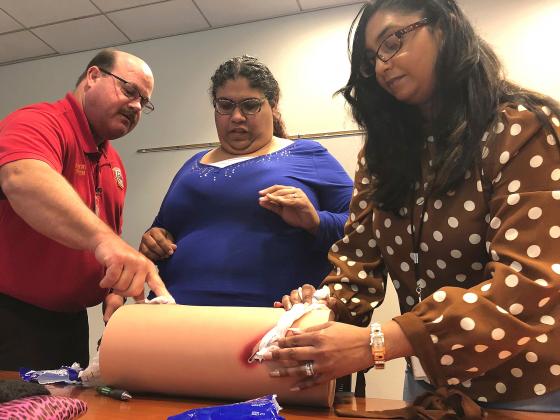Subhead
Kissimmee Fire Dept.: Stop the bleed, save a life
Image
Body
Whether it’s a slip-and-fall injury or a gunshot wound, blood loss is the No. 1 cause of preventable death from trauma.
It’s one of the first facts that the Kissimmee Fire Department teaches as part of the Stop the Bleed campaign, a national effort to train, equip and empower bystanders to help in a bleeding emergency before professionals
help arrives.
The campaign’s motto: “The only thing more tragic than a death from bleeding...is a death that could have been prevented.”
But what can the average person do to help a victim before emergency responders get to the scene?
A lot more than you might think, according to Kissimmee EMS Lt. Joan Robinson, who leads the Stop the Bleed campaign for the city of Kissimmee.
“Some of this is common sense, but it’s something that can save someone’s life,” Robinson told a group of city employees during a Stop the Bleed class Friday at City Hall.
The basics revolve around the “ABC”s.
• A – Alert – call 9-1-1.
• B – Bleeding – find the bleeding injury.
• C – Compress – apply pressure to stop the bleeding.
However, before applying any of the techniques, a bystander should first make sure they are safe.
“You don’t want to become a victim yourself,” Robinson said. “You have to help yourself before you can help anyone else.”
Next is 9-1-1.
“Please don’t assume someone’s called 9-1-1,” KFD Training Lt. Eric Gentry told the class. “You might see people on their phones but that doesn’t mean they’ve called 9-1-1.”
What’s more, finding the source of an injury can be difficult, but it’s necessary in order to apply compression to the wound, Gentry and Robinson told the class.
Compression is key. The three main techniques are:
1. Cover the wound with a clean cloth and apply pressure by pushing directly on it with both hands, or
2. Use a tourniquet, or
3. Pack/stuff the wound with gauze or a clean cloth and then applying pressure with both hands.
“The patient is going to scream if they’re conscious. It’s going to hurt,” Gentry said. “It’s gruesome and what you do is going to be painful and it’s hard, but believe me, you’re making a difference.”
When a patient isn’t expressing pain, it can be a sign that they’re in shock and even closer to death, he said.
The class centers around the basics of wound compression, using Stop the Bleed kits, which include protective gloves, a tourniquet, compression gauze, scissors, a chest seal and other first-aid items.
“The more people who get trained in our community, the safer we’ll all be,” Robinson said.
Stop the Bleed is an effort of the American College of Surgeons, The Committee on Trauma and The Hartford Consensus.
The ACS convened the Joint Committee to Create a National Policy to Enhance Survivability from Intentional Mass Casualty and Active Shooter Events in April 2013, a few months after the shooting at Sandy Hook Elementary School in Newtown, Conn., that killed 27 people, 20 of them children.
The committee met in collaboration with the medical community and representatives from the federal government, the National Security Council, the U.S. military, the Federal Bureau of Investigation and emergency medical response organizations. It was formed to create a protocol for national policy to enhance survivability from active shooter and intentional mass casualty events.
The White House launched Stop the Bleed in October 2015.
The city of Kissimmee requires all employees to take the Stop the Bleed course and has placed Stop the Bleed kits at City Hall, the Civic Center, Chambers Park and other locations.
It’s one of the first facts that the Kissimmee Fire Department teaches as part of the Stop the Bleed campaign, a national effort to train, equip and empower bystanders to help in a bleeding emergency before professionals
help arrives.
The campaign’s motto: “The only thing more tragic than a death from bleeding...is a death that could have been prevented.”
But what can the average person do to help a victim before emergency responders get to the scene?
A lot more than you might think, according to Kissimmee EMS Lt. Joan Robinson, who leads the Stop the Bleed campaign for the city of Kissimmee.
“Some of this is common sense, but it’s something that can save someone’s life,” Robinson told a group of city employees during a Stop the Bleed class Friday at City Hall.
The basics revolve around the “ABC”s.
• A – Alert – call 9-1-1.
• B – Bleeding – find the bleeding injury.
• C – Compress – apply pressure to stop the bleeding.
However, before applying any of the techniques, a bystander should first make sure they are safe.
“You don’t want to become a victim yourself,” Robinson said. “You have to help yourself before you can help anyone else.”
Next is 9-1-1.
“Please don’t assume someone’s called 9-1-1,” KFD Training Lt. Eric Gentry told the class. “You might see people on their phones but that doesn’t mean they’ve called 9-1-1.”
What’s more, finding the source of an injury can be difficult, but it’s necessary in order to apply compression to the wound, Gentry and Robinson told the class.
Compression is key. The three main techniques are:
1. Cover the wound with a clean cloth and apply pressure by pushing directly on it with both hands, or
2. Use a tourniquet, or
3. Pack/stuff the wound with gauze or a clean cloth and then applying pressure with both hands.
“The patient is going to scream if they’re conscious. It’s going to hurt,” Gentry said. “It’s gruesome and what you do is going to be painful and it’s hard, but believe me, you’re making a difference.”
When a patient isn’t expressing pain, it can be a sign that they’re in shock and even closer to death, he said.
The class centers around the basics of wound compression, using Stop the Bleed kits, which include protective gloves, a tourniquet, compression gauze, scissors, a chest seal and other first-aid items.
“The more people who get trained in our community, the safer we’ll all be,” Robinson said.
Stop the Bleed is an effort of the American College of Surgeons, The Committee on Trauma and The Hartford Consensus.
The ACS convened the Joint Committee to Create a National Policy to Enhance Survivability from Intentional Mass Casualty and Active Shooter Events in April 2013, a few months after the shooting at Sandy Hook Elementary School in Newtown, Conn., that killed 27 people, 20 of them children.
The committee met in collaboration with the medical community and representatives from the federal government, the National Security Council, the U.S. military, the Federal Bureau of Investigation and emergency medical response organizations. It was formed to create a protocol for national policy to enhance survivability from active shooter and intentional mass casualty events.
The White House launched Stop the Bleed in October 2015.
The city of Kissimmee requires all employees to take the Stop the Bleed course and has placed Stop the Bleed kits at City Hall, the Civic Center, Chambers Park and other locations.




